Hundred Years War
Hundred Years' War
| Hundred Years' War | |||||||||||||||||||||||||||||||||||||||||||||||||||||||||||||
|---|---|---|---|---|---|---|---|---|---|---|---|---|---|---|---|---|---|---|---|---|---|---|---|---|---|---|---|---|---|---|---|---|---|---|---|---|---|---|---|---|---|---|---|---|---|---|---|---|---|---|---|---|---|---|---|---|---|---|---|---|---|
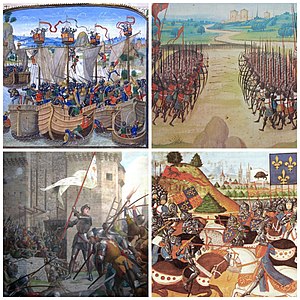 Clockwise, from top left: The Battle of La Rochelle, The Battle of Agincourt, The Battle of Patay, Joan of Arc at the Siege of Orléans | |||||||||||||||||||||||||||||||||||||||||||||||||||||||||||||
| |||||||||||||||||||||||||||||||||||||||||||||||||||||||||||||
| Belligerents | |||||||||||||||||||||||||||||||||||||||||||||||||||||||||||||
|
House of Valois |
House of Plantagenet | ||||||||||||||||||||||||||||||||||||||||||||||||||||||||||||
| States who shifted allegiances throughout the conflict have an asterisk ( * ) next to their names. They are shown in the side on which their participation was the most noteworthy. | |||||||||||||||||||||||||||||||||||||||||||||||||||||||||||||
| Commanders and leaders | |||||||||||||||||||||||||||||||||||||||||||||||||||||||||||||
|
| ||||||||||||||||||||||||||||||||||||||||||||||||||||||||||||
|
Hundred Years' War
Edwardian phase (1337–60) | |||||||||||||||||||||||||||||||||||||||||||||||||||||||||||||
|
Hundred Years' War
Caroline phase· (1369–89) | |||||||||||||||||||||||||||||||||||||||||||||||||||||||||||||
|
Hundred Years' War
Lancastrian phase (1415–53) | |||||||||||||||||||||||||||||||||||||||||||||||||||||||||||||
| Philip III r. 1270–1285 | |||||||||||||||||||||||||||||||||||||||||||||||||||||||||||||
| Philip IV r. 1285–1314 | Charles of France d. 1325 | Louis of France (1276–1319) | |||||||||||||||||||||||||||||||||||||||||||||||||||||||||||
| Louis X | Philip V | Charles IV | Isabella | Edward II | Philip VI r. 1328–1350 | Philip of Evreux r. 1328 – 1343 | |||||||||||||||||||||||||||||||||||||||||||||||||||||||
| Joan II b. 1312 | Joan III of Burgundy b. 1308 | Edward III b. 1312 | |||||||||||||||||||||||||||||||||||||||||||||||||||||||||||
| Charles of Évreux b. 1332 | Philip of Burgundy b. 1323 | ||||||||||||||||||||||||||||||||||||||||||||||||||||||||||||
|
Hundred Years' War
Edwardian phase (1337–60) | |||||||||||||||||||||||||||||||||||||||||||||||||||||||||||||
|
Hundred Years' War
Caroline phase· (1369–89) | |||||||||||||||||||||||||||||||||||||||||||||||||||||||||||||
|
Hundred Years' War
Lancastrian phase (1415–53) | |||||||||||||||||||||||||||||||||||||||||||||||||||||||||||||
|
Burgundian Wars (1474–77)
| |||||||||||||||||||||||||||||||||||||||||||||||||||||||||||||
| Arms | Historical Figure | Life | Notes | ||||||||||||||||||||||||||||||||||||||||||||||||||||||||||

|
King Philip VI | 1293–1350, reigned 1328–1350 | Charles of Valois' son | ||||||||||||||||||||||||||||||||||||||||||||||||||||||||||
| King John II | 1319–1364, reigned 1350–1364 | Philip VI's son | |||||||||||||||||||||||||||||||||||||||||||||||||||||||||||
| King Charles V | 1338–1380, reigned 1364–1380 | John II's son | |||||||||||||||||||||||||||||||||||||||||||||||||||||||||||

|
Bertrand du Guesclin | 1320–1380 | Commander | ||||||||||||||||||||||||||||||||||||||||||||||||||||||||||

|
Louis I, Duke of Anjou | 1339–1384, regent 1380–1382 | John II's son | ||||||||||||||||||||||||||||||||||||||||||||||||||||||||||

|
King Charles VI | 1368–1422, reigned 1380–1422 | Charles V's son | ||||||||||||||||||||||||||||||||||||||||||||||||||||||||||
| King Charles VII | 1403–1461, reigned 1422–1461 | Charles VI's son | |||||||||||||||||||||||||||||||||||||||||||||||||||||||||||
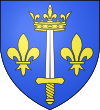
|
Joan of Arc | 1412–1431 | Religious visionary | ||||||||||||||||||||||||||||||||||||||||||||||||||||||||||

|
La Hire | 1390–1443 | Commander | ||||||||||||||||||||||||||||||||||||||||||||||||||||||||||
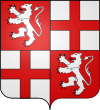
|
Jean Poton de Xaintrailles | 1390–1461 | Commander | ||||||||||||||||||||||||||||||||||||||||||||||||||||||||||

|
Jean II, Duke of Alençon | 1409–1476 | Commander | ||||||||||||||||||||||||||||||||||||||||||||||||||||||||||

|
Jean de Dunois | 1402–1468 | Commander | ||||||||||||||||||||||||||||||||||||||||||||||||||||||||||

|
Jean Bureau | 1390–1463 | Master Gunner | ||||||||||||||||||||||||||||||||||||||||||||||||||||||||||

|
Gilles de Rais | 1405–1440 | Commander | ||||||||||||||||||||||||||||||||||||||||||||||||||||||||||
| Arms | Historical Figure | Life | Notes | ||||||||||||||||||||||||||||||||||||||||||||||||||||||||||

|
Isabella of France | 1295–1358 | Queen consort of England, wife of Edward II, mother of Edward III, regent of England, sister of Charles IV and daughter of Philip IV of France | ||||||||||||||||||||||||||||||||||||||||||||||||||||||||||

|
King Edward III | 1312–1377, reigned 1327–1377 | Philip IV's grandson | ||||||||||||||||||||||||||||||||||||||||||||||||||||||||||
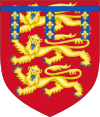
|
Henry of Grosmont, 1st Duke of Lancaster | 1310–1361 | Commander | ||||||||||||||||||||||||||||||||||||||||||||||||||||||||||
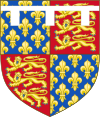
|
Edward, the Black Prince | 1330–1376 | Edward III's son | ||||||||||||||||||||||||||||||||||||||||||||||||||||||||||
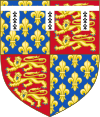
|
John of Gaunt, 1st Duke of Lancaster | 1340–1399 | Edward III's son | ||||||||||||||||||||||||||||||||||||||||||||||||||||||||||
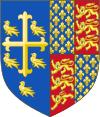
|
King Richard II | 1367–1400, reigned 1377–1399 | Son of the Black Prince, Edward III's grandson | ||||||||||||||||||||||||||||||||||||||||||||||||||||||||||

|
King Henry IV | 1367–1413, reigned 1399–1413 | John of Gaunt's son, Edward III's grandson | ||||||||||||||||||||||||||||||||||||||||||||||||||||||||||
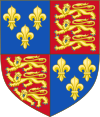
|
King Henry V | 1387–1422, reigned 1413–1422 | Henry IV's son | ||||||||||||||||||||||||||||||||||||||||||||||||||||||||||

|
Catherine of Valois | 1401–1437 | Queen consort of England, daughter of Charles VI of France, mother of Henry VI of England and by her second marriage grandmother of Henry VII | ||||||||||||||||||||||||||||||||||||||||||||||||||||||||||

|
John of Lancaster, 1st Duke of Bedford | 1389–1435, regent 1422–1435 | Henry IV's son | ||||||||||||||||||||||||||||||||||||||||||||||||||||||||||

|
Sir John Fastolf[76] | 1380–1459 | Commander | ||||||||||||||||||||||||||||||||||||||||||||||||||||||||||

|
John Talbot, 1st Earl of Shrewsbury | 1387–1453 | Commander | ||||||||||||||||||||||||||||||||||||||||||||||||||||||||||

|
King Henry VI | 1421–1471, reigned 1422–1461 (also 1422–1453 as king Henry II of France) | Henry V's son, grandson of Charles VI of France | ||||||||||||||||||||||||||||||||||||||||||||||||||||||||||

|
Richard Plantagenet, 3rd Duke of York | 1411–1460 | Commander | ||||||||||||||||||||||||||||||||||||||||||||||||||||||||||
| Arms | Historical Figure | Life | Notes | ||||||||||||||||||||||||||||||||||||||||||||||||||||||||||

|
Philip the Bold, Duke of Burgundy | 1342–1404, duke 1363–1404 | Son of John II of France | ||||||||||||||||||||||||||||||||||||||||||||||||||||||||||

|
John the Fearless, Duke of Burgundy | 1371–1419, duke 1404–1419 | Son of Philip the Bold | ||||||||||||||||||||||||||||||||||||||||||||||||||||||||||

|
Philip the Good, Duke of Burgundy | 1396–1467, duke 1419–1467 | Son of John the Fearless | ||||||||||||||||||||||||||||||||||||||||||||||||||||||||||
Tensions between the crowns of France and England can be traced back to the origins of the English royal family itself, who was French in origin. For this reason, English monarchs had historically held not only the English crown, but also titles and lands within France, the possession of which made them vassals to the kings of France. The status of the English king's French fiefs was a major source of conflict between both monarchies throughout the Middle Ages. French monarchs systematically sought to check the growth of English power, stripping away lands and titles as the opportunity arose, particularly whenever England was at war with Scotland, an ally of France. Over the centuries, English holdings in France had varied in size, at some points dwarfing even the French royal domain, but by 1337 only Gascony was left to the English.
In 1316, a principle was established denying women succession to the French throne. In 1328, Charles IV of France died without sons or brothers. His closest male relative was his nephew Edward III of England, whose mother, Isabella of France, was sister of the deceased king. Isabella claimed the throne of France for her son, but the French rejected it, maintaining that Isabella could not transmit a right she did not possess. Furthermore, political sentiment favored a Frenchman for the crown rather than a foreign prince. The throne passed instead to Philip of Valois, a patrilineal first cousin of Charles IV, who would become Philip VI of France, the first king of the House of Valois. The English had not expected their claim to meet with success, and did not press the matter when it was denied. However, disagreements between Philip and Edward induced the former to confiscate the latter's lands in France, and in turn prompted Edward III to reassert his claim to the French throne.
Several overwhelming English victories in the war—especially at Crécy, Poitiers, and Agincourt—raised the prospects of an ultimate English triumph, and convinced the English to continue pouring money and manpower into the war over many decades. However, the greater resources of the French monarchy precluded a complete conquest. Starting in 1429, decisive French victories at Orléans, Patay, Formigny, and Castillon concluded the war in favour of France, with England permanently losing most of its possessions on the continent.
Historians commonly divide the war into three phases separated by truces: the Edwardian War (1337–1360), the Caroline War (1369–1389), and the Lancastrian War (1415–1453). Each side drew many allies into the war: local conflicts in neighbouring areas, which were contemporarily related to the war, including the War of the Breton Succession (1341–1365), the Castilian Civil War (1366–1369), the War of the Two Peters (1356–1369) in Aragon, and the 1383–85 crisis in Portugal, were availed by the parties to advance their agendas. Later historians adopted the term "Hundred Years' War" as a historiography periodization to encompass all of these events, thus constructing the longest military conflict in European history.
The war owes its historical significance to multiple factors. By its end, feudal armies had been largely replaced by professional troops, and aristocratic dominance had yielded to a democratisation of the manpower and weapons of armies. Although primarily a dynastic conflict, the war gave impetus to ideas of French and English nationalism. The wider introduction of weapons and tactics supplanted the feudal armies where heavy cavalry had dominated, and artillery became important. The war precipitated the creation of the first standing armies in Western Europe since the time of the Western Roman Empire and thus helping to change their role in warfare. With respect to the belligerents, in France, civil wars, deadly epidemics, famines, and bandit free-companies of mercenaries reduced the population drastically. In England, political forces over time came to oppose the costly venture. The dissatisfaction of English nobles, resulting from the loss of their continental landholdings, as well as the general shock at losing a war in which investment had been so great, became factors leading to the Wars of the Roses (1455–1487).
Contents
- 1 Origin of the conflict
- 2 Beginning of the war: 1337–1360
- 3 First peace: 1360–1369
- 4 French ascendancy under Charles V: 1369–1389
- 5 Second peace: 1389–1415
- 6 Resumption of the war under Henry V: 1415–1429
- 7 French victory: 1429–1453
- 8 Significance
- 9 Timeline
- 10 Important figures
- 11 See also
- 12 Notes
- 13 References
- 14 Further reading
- 15 External links
Origin of the conflict
The root causes of the conflict can be found in the demographic, economic and political crises of 14th century Europe. The outbreak of war was motivated by a gradual rise in tension between the kings of France and England about Gascony, Flanders and Scotland. The dynastic question, which arose due to an interruption of the direct male line of the Capetians, was the official pretext.Dynastic turmoil in France: 1316–1328
The question of female succession to the French throne was raised after the death of Louis X in 1316. Louis X left only a daughter, and his posthumous son John I lived only a few days. Furthermore, the paternity of his daughter was in question, as her mother, Margaret of Burgundy, had been exposed as an adulterer in the Tour de Nesle affair. Philip, Count of Poitiers, brother of Louis X, positioned himself to take the crown, advancing the stance that women should be ineligible to succeed to the French throne. Through his political sagacity he won over his adversaries and succeeded to the French throne as Philip V. By the same law that he procured, his daughters were denied the succession, which passed to his younger brother, Charles IV, in 1322.[1]By proximity of blood, the nearest male relative of Charles IV was his nephew Edward III of England. Edward was the son of Isabella, the sister of the dead Charles IV, but the question arose whether she should be able to transmit a right to inherit that she did not herself possess. The French nobility, moreover, balked at the prospect of being ruled by Isabelle and her lover Roger Mortimer, who were widely suspected of having murdered the previous English king, Edward II. The assemblies of the French barons and prelates and the University of Paris decided that males who derive their right to inheritance through their mother should be excluded. Thus the nearest heir through male ancestry was Charles IV's first cousin, Philip, Count of Valois, and it was decided that he should be crowned Philip VI. In 1340 the Avignon papacy confirmed that under Salic law males should not be able to inherit through their mothers.[1][2]
Eventually, Edward III reluctantly recognized Philip VI and paid him homage for his French fiefs. He made concessions in Guyenne, but reserved the right to reclaim territories arbitrarily confiscated. After that, he expected to be left undisturbed while he made war on Scotland.
The dispute over Guyenne: a problem of sovereignty
Homage of Edward I of England (kneeling) to Philip IV of France (seated), 1286. As Duke of Aquitaine, Edward was also a vassal to the French King. Illumination by Jean Fouquet from the Grandes Chroniques de France in the Bibliothèque Nationale de France, Paris.
The Anglo-Norman dynasty that had ruled England since the Norman conquest of 1066 was brought to an end when Henry, the son of Geoffrey of Anjou and Empress Matilda and great-grandson of William the Conqueror, became the first of the Angevin kings of England in 1154 as Henry II.[3] The Angevin kings directly ruled over more French territory than the kings of France. However, they still owed homage for these territories to the French king. From the 11th century onward, the Angevins had autonomy within their French domains, effectively neutralizing the issue.[4]
King John of England inherited the Angevin domains from his brother Richard I. However, Philip II of France acted decisively to exploit the weaknesses of John, both legally and militarily, and by 1204 had succeeded in taking control of much of the Angevin continental possessions. Following John's reign, the Battle of Bouvines (1214), the Saintonge War (1242), and finally the War of Saint-Sardos (1324), the English king's holdings on the continent, as Duke of Aquitaine (Guyenne), were limited roughly to provinces in Gascony.[5]
The dispute over Guyenne is even more important than the dynastic question in explaining the outbreak of the war. Guyenne posed a significant problem to the kings of France and England: Edward III was a vassal of Philip VI of France because of his French possessions and was required to recognize the suzerainty of the King of France over them. In practical terms, a judgment in Guyenne might be subject to an appeal to the French royal court. The King of France had the power to revoke all legal decisions made by the King of England in Aquitaine, which was unacceptable to the English. Therefore, sovereignty over Guyenne was a latent conflict between the two monarchies for several generations.
During the War of Saint-Sardos, Charles of Valois, father of Philip VI, invaded Aquitaine on behalf of Charles IV and conquered the duchy after a local insurrection, which the French believed had been incited by Edward II of England. Charles IV grudgingly agreed to return this territory in 1325. To recover his duchy, Edward II had to compromise: he sent his son, the future Edward III, to pay homage.
The King of France agreed to restore Guyenne, minus Agen. But the French delayed the return of the lands, which helped Philip VI. On 6 June 1329, Edward III finally paid homage to the King of France. However, at the ceremony, Philip VI had it recorded that the homage was not due to the fiefs detached from the duchy of Guyenne by Charles IV (especially Agen). For Edward, the homage did not imply the renunciation of his claim to the extorted lands.
Gascony under the King of England
France in 1330.
France before 1214
French acquisitions until 1330
England and Guyenne/Gascony as of 1330
For the first 10 years of Edward III's reign, Gascony had been a major point of friction. The English argued that, as Charles IV had not acted in a proper way towards his tenant, Edward should be able to hold the duchy free of any French suzerainty. This argument was rejected by the French, so in 1329, the 17-year-old Edward III paid homage to Philip VI. Tradition demanded that vassals approach their liege unarmed with heads bare. Edward protested by attending the ceremony wearing his crown and sword.[9] Even after this pledge of homage, the French continued to pressure the English administration.[10]
Gascony was not the only sore point. One of Edward's influential advisers was Robert III of Artois. Robert was an exile from the French court, having fallen out with Philip VI over an inheritance claim. He urged Edward to start a war to reclaim France, and was able to provide extensive intelligence on the French court.[11]
Franco-Scot alliance
France was an ally of the Kingdom of Scotland as English kings had for some time tried to subjugate the area. In 1295, a treaty was signed between France and Scotland during the reign of Philip the Fair. Charles IV formally renewed the treaty in 1326, promising Scotland that France would support the Scots if England invaded their country. Similarly, France would have Scotland's support if its own kingdom was attacked. Edward could not succeed in his plans for Scotland if the Scots could count on French support.[12]Philip VI had assembled a large naval fleet off Marseilles as part of an ambitious plan for a crusade to the Holy Land. However, the plan was abandoned and the fleet, including elements of the Scottish Navy, moved to the English Channel off Normandy in 1336, threatening England.[11] To deal with this crisis, Edward proposed that the English raise two armies, one to deal with the Scots "at a suitable time", the other to proceed at once to Gascony. At the same time, ambassadors were to be sent to France with a proposed treaty for the French king.[13]
Beginning of the war: 1337–1360
End of homage
At the end of April 1337, Philip of France was invited to meet the delegation from England but refused. The arrière-ban, literally a call to arms, was proclaimed throughout France starting on 30 April 1337. Philip then met with his Great Council in Paris. On 24 May 1337, it was agreed that the Duchy of Aquitaine, effectively Gascony, should be taken back into the king's hands on the grounds that Edward III was in breach of his obligations as vassal and had sheltered the king's 'mortal enemy' Robert d'Artois.[14] Edward responded to the confiscation of Aquitaine by challenging Philip's right to the French throne. When Charles IV died, Edward had made a claim for the succession of the French throne, through the right of his mother Isabella (Charles IV's sister), daughter of Philip IV. Any claim was considered invalidated by Edward's homage to Philip VI in 1329. Edward revived his claim and in 1340 formally assumed the title 'King of France and the French Royal Arms'.[15]On 26 January 1340, Edward III formally received homage from Guy, half-brother of the Count of Flanders. The civic authorities of Ghent, Ypres and Bruges proclaimed Edward King of France. Edward's purpose was to strengthen his alliances with the Low Countries. His supporters would be able to claim that they were loyal to the "true" King of France and were not rebels against Philip. In February 1340, Edward returned to England to try to raise more funds and also deal with political difficulties.[16]
Relations with Flanders were also tied to the English wool trade, since Flanders' principal cities relied heavily on textile production and England supplied much of the raw material they needed. Edward III had commanded that his chancellor sit on the woolsack in council as a symbol of the pre-eminence of the wool trade.[17] At the time there were about 110,000 sheep in Sussex alone.[18] The great medieval English monasteries produced large surpluses of wool that were sold to mainland Europe. Successive governments were able to make large amounts of money by taxing it.[17] France's sea power led to economic disruptions for England, shrinking the wool trade to Flanders and the wine trade from Gascony.[19][20]
Outbreak, the English Channel and Brittany
In 1341, conflict over the succession to the Duchy of Brittany began the War of the Breton Succession, in which Edward backed John of Montfort and Philip backed Charles of Blois. Action for the next few years focused around a back and forth struggle in Brittany. The city of Vannes in Brittany changed hands several times, while further campaigns in Gascony met with mixed success for both sides.[21] The English backed Montfort finally succeeded in taking the duchy but not until in 1364.[22]
Battle of Crécy and the taking of Calais
Edward III counting the dead on the battlefield of Crécy
The Battle of Crécy was a complete disaster for the French, largely credited to the longbowmen and the French king, who allowed his army to attack before it was ready.[23] Philip appealed to his Scottish allies to help with a diversionary attack on England. King David II of Scotland responded by invading northern England, but his army was defeated and he was captured at the Battle of Neville's Cross, on 17 October 1346. This greatly reduced the threat from Scotland.[21][24] In France, Edward proceeded north unopposed and besieged the city of Calais on the English Channel, capturing it in 1347. This became an important strategic asset for the English, allowing them to safely keep troops in northern France.[23] Calais would remain under English control, even after the end of the Hundred Years' War, until the successful French siege in 1558.[25]
Battle of Poitiers
In 1348, the Black Death, which had just arrived in Paris, began to ravage Europe.[26] In 1355, after the plague had passed and England was able to recover financially,[citation needed] King Edward's son and namesake, the Prince of Wales, later known as the Black Prince, led a Chevauchée from Gascony into France, during which he pillaged Avignonet and Castelnaudary, sacked Carcassonne, and plundered Narbonne. The next year during another Chevauchée he ravaged Auvergne, Limousin, and Berry but failed to take Bourges. He offered terms of peace to King John II of France (known as John the Good), who had outflanked him near Poitiers, but refused to surrender himself as the price of their acceptance. This led to the Battle of Poitiers (19 September 1356) where his army routed the French.[27] During the battle, the Gascon noble Jean de Grailly, captal de Buch led a mounted unit that was concealed in a forest. The French advance was contained, at which point de Grailly led a flanking movement with his horsemen cutting off the French retreat and succeeding in capturing King John and many of his nobles.[28][29] With John held hostage, his son the Dauphin (later to become Charles V) assumed the powers of the king as regent.[30]After the Battle of Poitiers, many French nobles and mercenaries rampaged, and chaos ruled. A contemporary report recounted:
... all went ill with the kingdom and the State was undone. Thieves and robbers rose up everywhere in the land. The Nobles despised and hated all others and took no thought for usefulness and profit of lord and men. They subjected and despoiled the peasants and the men of the villages. In no wise did they defend their country from its enemies; rather did they trample it underfoot, robbing and pillaging the peasants' goods ...
From the Chronicles of Jean de Venette[31]
Reims Campaign and Black Monday
Black Monday (1360), hailstorms and lighting ravage the English army at Chartres
First peace: 1360–1369
The French king, John II, had been held captive in England. The Treaty of Brétigny set his ransom at 3 million crowns and allowed for hostages to be held in lieu of John. The hostages included two of his sons, several princes and nobles, four inhabitants of Paris, and two citizens from each of the nineteen principal towns of France. While these hostages were held, John returned to France to try and raise funds to pay the ransom. In 1362 John's son Louis of Anjou, a hostage in English-held Calais, escaped captivity. So, with his stand-in hostage gone, John felt honor-bound to return to captivity in England.[30][36]The French crown had been at odds with Navarre (near southern Gascony) since 1354, and in 1363 the Navarrese used the captivity of John II in London and the political weakness of the Dauphin to try to seize power.[37] Although there was no formal treaty, Edward III supported the Navarrese moves, particularly as there was a prospect that he might gain control over the northern and western provinces as a consequence. With this in mind, Edward deliberately slowed the peace negotiations.[38] In 1364, John II died in London, while still in honourable captivity.[39] Charles V succeeded him as king of France.[30][40] On 7 May 1364, one month after the dauphin's accession and three days before his coronation as Charles V, the Navarrese suffered a crushing defeat at the Battle of Cocherel.[41]
French ascendancy under Charles V: 1369–1389
Aquitaine and Castile
Henry kills his half-brother Peter. His ascent to power as Henry II shifted Castile's alliance from England back to its traditional ally, France. The English merchant community that had been established in Seville was massacred on Henry II's order.[42] Between 1372 and 1380, the Castilian galley fleet raided the southern coasts of England with relative impunity, turning the tide in the Hundred Years' War decisively in France's favour.[43]
Peter appealed to England and Aquitaine's Black Prince for help, but none was forthcoming, forcing Peter into exile in Aquitaine. The Black Prince had previously agreed to support Peter's claims but concerns over the terms of the treaty of Brétigny led him to assist Peter as a representative of Aquitaine, rather than England. He then led an Anglo-Gascon army into Castille. Peter was restored to power after Trastámara's army was defeated at the Battle of Nájera.[45]
Although the Castilians had agreed to fund the Black Prince, they failed to do so. The Prince was suffering from ill health and returned with his army to Aquitaine. To pay off debts incurred during the Castille campaign, the prince instituted a hearth tax. Arnaud-Amanieu VIII, Lord of Albret had fought on the Black Prince's side during the war. Albret, who already had become discontented by the influx of English administrators into the enlarged Aquitaine, refused to allow the tax to be collected in his fief. He then joined a group of Gascon lords who appealed to Charles V for support in their refusal to pay the tax. Charles V summoned one Gascon lord and the Black Prince to hear the case in his High Court in Paris. The Black Prince answered that he would go to Paris with sixty thousand men behind him. War broke out again and Edward III resumed the title of King of France.[46] Charles V declared that all the English possessions in France were forfeited, and before the end of 1369 all of Aquitaine was in full revolt.[46][47]
With the Black Prince gone from Castile, Henry de Trastámara led a second invasion that ended with Peter's death at the Battle of Montiel in March 1369. The new Castilian regime provided naval support to French campaigns against Aquitaine and England.[45]
In 1373, the combined Castilian and French fleets sacked the Isle of Wight. In 1377, they burned Rye and Hastings and sacked Lewes, Folkestone, Portsmouth, Dartmouth, and Plymouth. In 1378, the Castilian galleys raided Cornwall, burning coastal towns and levying tribute.[48] The following year the Castilians conquered the Castle of La Roche Guyon on the Breton coast. In July 1380, Fernando Sánchez de Tovar led a Franco-Castilian fleet from La Rochelle in an attack on Jersey and Guernsey, followed by an August raid into the Thames Estuary. The raiders burned Gravesend, while the Londoners watched the flames from a distance.[49]
1373 campaign of John of Gaunt
In August 1373, John of Gaunt, accompanied by John de Montfort, Duke of Brittany led a force of 9,000 men out from Calais on a major chevauchée. While initially successful as French forces were insufficiently concentrated to oppose them, the English began to meet further resistance as they moved south. French forces began to concentrate around the English force but, under specific orders from King Charles V, the French avoided a set battle. Instead, they fell on forces detached from the main body to raid or forage. The French shadowed the English and in October, the English found themselves being trapped against the River Allier by four separate French forces. With some difficulty, the English crossed at the bridge at Moulins but lost all their baggage and loot. The English carried on south across the Limousin plateau but the weather was turning severe. Men and horses died in great numbers and many soldiers, forced to march on foot, discarded their armour. At the beginning of December, the army finally entered friendly territory in Gascony. By the end of December they were in Bordeaux, starving, ill-equipped and having lost over half of the 30,000 horses with which they had left Calais. Although the march across France had been a remarkable feat, it was a military failure.[50]English turmoil
With his health continuing to deteriorate, the Black Prince returned to England in January 1371, whereby now his father Edward III was elderly and also in poor health. The prince's illness was debilitating, and he died on 8 June 1376.[51]Edward III died the following year on 21 June 1377;[52] he was succeeded by the Black Prince's second son Richard II (the first son had died sometime earlier), who was still a child.[53] The treaty at Brétigny left Edward III and England with enlarged holdings in France; however, a small professional French army under the leadership of du Guesclin pushed the English back and, by the time of Charles V's death in 1380, the English only held Calais and a few other coastal cities.[54]
It was usual to appoint a regent in the case of a child monarch, but no regent was appointed for Richard II, who nominally exercised the power of kingship from the date of his accession in 1377.[53] However, between 1377 and 1380, actual power was in the hands of a series of councils. The political community preferred this to a regency led by the king's uncle, John of Gaunt, although Gaunt remained highly influential.[53]
Richard faced many challenges during his reign, including the Peasants' Revolt led by Wat Tyler in 1381 and an Anglo-Scottish war in 1384–1385. His attempts to raise taxes to pay for his Scottish adventure and for the protection of Calais against the French made him increasingly unpopular.[53]
1380 campaign of the Earl of Buckingham
In July 1380, the Earl of Buckingham commanded an expedition to France to aid England's ally, the Duke of Brittany. The French refused battle before the walls of Troyes on 25 August, so Buckingham's forces continued their chevauchée and in November laid siege to Nantes.[55] However, expected support from the Duke of Brittany did not appear and, in the face of heavy losses in both men and horses, was forced to abandon the siege in January 1381.[56] In February 1381, now reconciled to the regime of the new French king Charles VI, Brittany paid 50,000 francs to Buckingham for him to abandon the siege and the campaign.[57]French turmoil
After the deaths of Charles V and du Guesclin in 1380, France lost its main leadership and overall momentum in the war. Charles VI succeeded his father as king of France at the age of 11, and he was thus put under a regency led by his uncles, who managed to maintain an effective grip on government affairs until about 1388, well after Charles had achieved royal majority.With France facing widespread destruction, plague, and economic recession, high taxation put a heavy burden on the French peasantry and urban communities. The war effort against England largely depended on royal taxation, but the population was increasingly unwilling to pay for it, as would be demonstrated at the Harelle and Maillotin revolts in 1382. Charles V had abolished many of these taxes on his deathbed, but subsequent attempts to reinstate them stirred up hostility between the French government and populace.
Difficulties in raising taxes and revenue hampered the ability of the French to fight the English. At this point, the war's pace had largely slowed down, and both nations found themselves fighting mainly through proxy wars, such as during the 1383–1385 Portuguese interregnum. The independence party in the Kingdom of Portugal, which was supported by the English, won against the supporters of the King of Castile's claim to the Portuguese throne, who in turn was backed by the French.
Second peace: 1389–1415
France in 1388, just before signing a truce. English territories are shown in red, French royal territories are dark blue, papal territories are orange, and French vassals have the other colors.
In 1389, Richard's uncle and supporter, John of Gaunt, returned from Spain and Richard was able to rebuild his power gradually until 1397, when he reasserted his authority and destroyed the principal three among the Lords Appellant. In 1399, after John of Gaunt died, Richard II disinherited Gaunt's son, the exiled Henry of Bolingbroke. Bolingbroke returned to England with his supporters and deposed Richard and had himself crowned Henry IV.[53][59][60]
In Scotland, the problems brought in by the English regime change prompted border raids that were countered by an invasion in 1402 and the defeat of a Scottish army at the Battle of Homildon Hill.[61] A dispute over the spoils between Henry and Henry Percy, 1st Earl of Northumberland, resulted in a long and bloody struggle between the two for control of northern England, resolved only with the almost complete destruction of the Percy family by 1408.[62][63]
In Wales, Owain Glyndŵr was declared Prince of Wales on 16 September 1400. He was the leader of the most serious and widespread rebellion against English authority in Wales since the conquest of 1282–1283. In 1405, the French allied with Glyndŵr and the Castilians in Spain and a Franco-Welsh army advanced as far as Worcester, while the Spaniards used galleys to raid and burn all the way from Cornwall to Southampton, before taking refuge in Harfleur for the winter.[64] The rebellion was finally put down only in 1415 and resulted in Welsh semi-independence for a number of years.[65]
In 1392, Charles VI suddenly descended into madness, forcing France into a regency dominated by his uncles and his brother. An open conflict for control over the Regency began between his uncle Philip the Bold, Duke of Burgundy, and his brother, Louis of Valois, Duke of Orléans. After Philip's death, his son and heir John the Fearless continued the struggle against Louis, but with the disadvantage of having no close personal relation to the king. Finding himself outmaneuvered politically, John ordered the assassination of Louis in retaliation. His involvement in the murder was quickly revealed, and the Armagnac family took political power in opposition to John. By 1410, both sides were bidding for the help of English forces in a civil war.[60] In 1418 Paris was taken by the Burgundians, who were unable to stop the massacre of Count of Armagnac and about 2,500 of his followers by a Parisian mob.[66]
Throughout this period, England confronted repeated raids by pirates that heavily damaged trade and the navy. There is some evidence that Henry IV used state-legalised piracy as a form of warfare in the English Channel. He used such privateering campaigns to pressure enemies without risking open war.[67] The French responded in kind and French pirates, under Scottish protection, raided many English coastal towns.[68]
The domestic and dynastic difficulties faced by England and France in this period quieted the war for a decade.[68]
Henry IV of England died in 1413 and was replaced by his eldest son Henry V. The mental illness of Charles VI of France allowed his power to be exercised by royal princes whose rivalries caused deep divisions in France. Henry V was well aware of these divisions and hoped to exploit them. In 1414 while he held court at Leicester, he received ambassadors from Burgundy.[69] Henry accredited envoys to the French king to make clear his territorial claims in France; he also demanded the hand of Charles VI's youngest daughter Catherine of Valois. The French rejected his demands, leading Henry to prepare for war.[69]
Resumption of the war under Henry V: 1415–1429
Burgundy alliance and the seizure of Paris
Battle of Agincourt (1415)
Fifteenth-century miniature depicting the Battle of Agincourt of 1415.
Treaty of Troyes (1420)
Clan Carmichael crest with broken spear commemorating the unseating of the Duke of Clarence.
Death of Clarence (1421)
On 22 March 1421 Henry V's progress in his French campaign experienced an unexpected reverse. Henry had left his brother and presumptive heir Thomas, Duke of Clarence in charge while he returned to England. Clarence engaged a Franco-Scottish force of 5000 men, led by Gilbert Motier de La Fayette and John Stewart, Earl of Buchan at the Battle of Baugé. Clarence, against the advice of his lieutenants, before his army had been fully assembled, attacked with a force of no more than 1500 men-at-arms. He then, during the course of the battle, led a charge of a few hundred men into the main body of the Franco-Scottish army, who quickly enveloped the English. In the ensuing melée, the Scot, John Carmichael of Douglasdale, broke his lance unhorsing the Duke of Clarence. Once on the ground, the duke was slain by Alexander Buchanan.[69][71] The body of the Duke of Clarence was recovered from the field by Thomas Montacute, 4th Earl of Salisbury, who conducted the English retreat.[72]English success
Henry V returned to France and went to Paris, then visiting Chartres and Gâtinais before returning to Paris. From there, he decided to attack the Dauphin-held town of Meaux. It turned out to be more difficult to overcome than first thought. The siege began about 6 October 1421, and the town held for seven months before finally falling on 11 May 1422.[69]At the end of May, Henry was joined by his queen and together with the French court, they went to rest at Senlis. While there, it became apparent that he was ill (possibly dysentery), and when he set out to the Upper Loire, he diverted to the royal castle at Vincennes, near Paris, where he died on 31 August 1422.[69] The elderly and insane Charles VI of France died two months later on 21 October 1422. Henry left an only child, his nine-month-old son, Henry, later to become Henry VI.[73]
On his deathbed, Henry V had given the Duke of Bedford responsibility for English France (as Henry VI was only an infant). The war in France continued under Bedford's generalship and several battles were won. The English won an emphatic victory at the Battle of Verneuil (17 August 1424). At the Battle of Baugé, Clarence had rushed into battle without the support of his archers. At Verneuil, the archers fought to devastating effect against the Franco-Scottish army. The effect of the battle was to virtually destroy the Dauphin's field army and to eliminate the Scots as a significant military force for the rest of the war.[73][74]
French victory: 1429–1453
Joan of Arc and French revival
Joan of Arc (picture c.1450–1500)
The English retreated from the Loire Valley, pursued by a French army. Near the village of Patay, French cavalry broke through a unit of English longbowmen that had been sent to block the road, then swept through the retreating English army. The English lost 2,200 men, and the commander, John Talbot, 1st Earl of Shrewsbury, was taken prisoner. This victory opened the way for the Dauphin to march to Reims for his coronation as Charles VII, on 16 July 1429.[75][76]
After the coronation, Charles VII's army fared less well. An attempted French siege of Paris was defeated on 8 September 1429, and Charles VII withdrew to the Loire Valley.[77]
Henry's coronations and the desertion of Burgundy
Henry VI was crowned king of England at Westminster Abbey on 5 November 1429 and king of France at Notre-Dame, in Paris, on 16 December 1431.[73]
The first Western image of a battle with cannon: the Siege of Orléans in 1429.
After the death of Joan of Arc, the fortunes of war turned dramatically against the English.[78] Most of Henry's royal advisers were against making peace. Among the factions, the Duke of Bedford wanted to defend Normandy, the Duke of Gloucester was committed to just Calais, whereas Cardinal Beaufort was inclined to peace. Negotiations stalled. It seems that at the congress of Arras, in the summer of 1435, where the duke of Beaufort was mediator, the English were unrealistic in their demands. A few days after the congress ended in September, Philip III, duke of Burgundy, deserted to Charles VII, signing the Treaty of Arras that returned Paris to the King of France. This was a major blow to English sovereignty in France.[73] The Duke of Bedford died on 14 September 1435 and was later replaced by Richard Plantagenet, 3rd Duke of York.[78]
French resurgence
The Battle of Formigny (1450)
By 1449, the French had retaken Rouen. In 1450 the Count of Clermont and Arthur de Richemont, Earl of Richmond, of the Montfort family (the future Arthur III, Duke of Brittany), caught an English army attempting to relieve Caen and defeated it at the Battle of Formigny. Richemont's force attacked the English army from the flank and rear just as they were on the verge of beating Clermont's army.[80]
Fall of Gascony
End of the war
Although the Battle of Castillon is considered the last battle of the Hundred Years' War,[81] England and France remained formally at war for another 20 years, but the English were in no position to carry on the war as they faced unrest at home. Following defeat in the Hundred Years' War, English landowners complained vociferously about the financial losses resulting from the loss of their continental holdings; this is often considered a major cause of the Wars of the Roses, that started in 1455.[78][82]The Hundred Years' War almost resumed in 1474, when the duke Charles of Burgundy, counting on English support, took up arms against Louis XI. Louis managed to isolate the Burgundians by buying Edward IV of England off with a large cash sum and an annual pension, in the Treaty of Picquigny (1475). The treaty formally ended the Hundred Years' War with Edward renouncing his claim to the throne of France. However, future Kings of England (and later of Great Britain) continued to claim the title until 1803, when they were dropped in deference to the exiled Count of Provence, titular King Louis XVIII, who was living in England after the French Revolution.[83]
Significance
Burgundian territories (orange/yellow) and limits of France (red) after the Burgundian War
Historical significance
The French victory marked the end of a long period of instability that had started with the Norman Conquest (1066), when William the Conqueror added "King of England" to his titles, becoming both the vassal to (as Duke of Normandy) and the equal of (as king of England) the king of France.[84]When the war ended, England was bereft of its Continental possessions, leaving it with only Calais on the continent. The war destroyed the English dream of a joint monarchy and led to the rejection in England of all things French, but the French language in England, which had served as the language of the ruling classes and commerce there from the time of the Norman conquest, left many vestiges in English vocabulary. English became the official language in 1362 and French was no longer used for teaching from 1385.[85]
National feeling that emerged from the war unified both France and England further. Despite the devastation on its soil, the Hundred Years' War accelerated the process of transforming France from a feudal monarchy to a centralised state.[86] In England the political and financial troubles which emerged from the defeat were a major cause of the War of the Roses (1455–1487).[82]
The spread of the Black Death (with modern borders)
Bubonic plague and warfare reduced population numbers throughout Europe during this period. France lost half its population during the Hundred Years' War.[70] Normandy lost three-quarters of its population, and Paris two-thirds.[88] The population of England was reduced by 20 to 33 percent due to plague in the same period.[89]
Military significance
In 1445 the first regular standing army in Western Europe since Roman times was organised in France partly as a solution to marauding free companies. The mercenary companies were given a choice of either joining the Royal army as compagnies d'ordonnance on a permanent basis, or being hunted down and destroyed if they refused. France gained a total standing army of around 6,000 men, which was sent out to gradually eliminate the remaining mercenaries who insisted on operating on their own. The new standing army had a more disciplined and professional approach to warfare than its predecessors.[90]The Hundred Years' War was a time of rapid military evolution. Weapons, tactics, army structure and the social meaning of war all changed, partly in response to the war's costs, partly through advancement in technology and partly through lessons that warfare taught. The feudal system was slowly disintegrating throughout the hundred years war.
By the war's end, although the heavy cavalry was still considered the most powerful unit in an army, the heavily armored horse had to deal with several tactics developed to deny or mitigate its effective use on a battlefield.[91] The English began using lightly armoured mounted troops, known as hobelars. Hobelars tactics had been developed against the Scots, in the Anglo-Scottish wars of the 14th century. Hobelars rode smaller unarmoured horses, enabling them to move through difficult or boggy terrain where heavier cavalry would struggle. Rather than fight while seated on the horse, they would dismount to engage the enemy.[90][92][93]







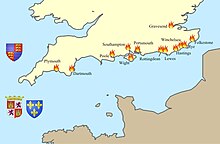





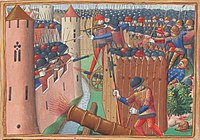


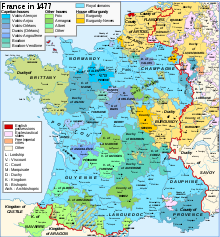


Comments
Post a Comment